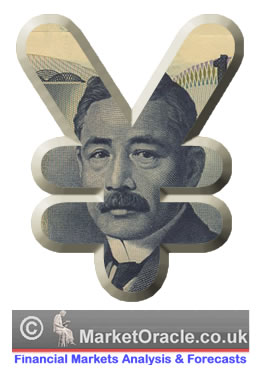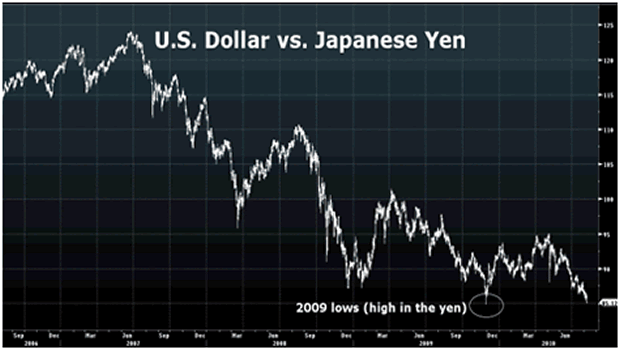Japanese Yen on Central Bank Intervention Watch
Currencies / Japanese Yen Aug 07, 2010 - 07:34 AM GMTBy: Bryan_Rich
 As major global economies are beginning to feel the threat of another bout with recession, Japan is dealing with an extra challenge: An unwelcomed strong currency.
As major global economies are beginning to feel the threat of another bout with recession, Japan is dealing with an extra challenge: An unwelcomed strong currency.
Weak structural economic fundamentals around the world and tough austerity are proving to squash the feeble recovery. And the likelihood of central banks returning to, or intensifying, the easy money policies are growing.
But these dynamics have not held back the yen’s surge. In fact, Japan’s currency has gained over 40 percent against the dollar since the economic crisis erupted in the middle of 2007. And despite the signs of global economies slowing, 8 percent of those gains have come in the past two months.
Here’s the question: With an economy that has suffered more than any other major economy in the 2007-2009 recession and is still stalled in record deflation, why would Japan’s currency be rising?
For one, the world has been deleveraging. When times were good, global capital piled into the carry trade — primarily borrowing cheap yen to buy higher yielding global assets. As such, the reversal of that trade has been a huge driver of yen strength, clearly marking a low in the yen at the onset of the crisis.
Now, in an environment dominated by risk aversion, the yen is continuing on its path of gains, thereby causing an increasingly threatening disadvantage for Japanese exporters — the lifeblood of the Japanese economy.
Exporters Feeling the Pain
|
This week, Japan’s automakers have been reporting earnings for the most recent quarter. But what’s stealing the headlines is what companies are saying about the outlook for their business, given the ever rising yen.
And it’s not good:
- Honda’s CFO said making vehicles in Japan at a dollar/yen exchange rate of 85 is “not economically feasible.”
- Honda’s CEO said if the Japanese government can’t stabilize the yen, key export businesses would have no choice but to leave the country.
- Nissan’s COO said he’s “very concerned” about the yen’s strength.
The rising yen against the dollar makes Japanese cars and electronics more expensive for American consumers, Japan’s biggest export market. And it makes the revenue earned from its U.S. manufacturing plants worth less when it’s translated back into their home currency.
Meanwhile, Japan’s key competitors for world exports, China and Korea, have become more attractive substitutes for global consumers.
In the past three months the Korean Won has weakened 14 percent against the yen. That means, in terms of trade, South Korea has gained a significant competitive advantage over Japan’s exports.
And because China keeps its currency more closely in-line with the dollar, its yuan has weakened just over 8 percent against the yen in the past few months.
Probability Rising for FX Intervention
Japan has a reputation for being sensitive to movements in the currency markets and for taking action. Its heaviest periods of intervention tended to coincide with slower economic growth rates — like it’s experiencing now.
|
The last time Japan intervened to weaken the yen was between 2003 and 2004 …
Over the course of 126 days the Ministry of Finance sold yen in the open market to purchase 315 billion U.S. dollars. These steps ultimately sent the yen 11 percent lower.
But the overall success of interventions in changing the long-term path of a currency is not great. A lot depends on how it’s done …
Changing the path of a currency tends to have a higher success rate when countries act together in support of (or against) the same currency. These coordinated interventions also have a greater spillover effect on other currencies.
The 85 level in USD/JPY seems to be where Japan says uncle … hostility ticks up and politicians start feeling the heat.
Following the Dubai sovereign debt shock in late 2009, the yen spiked to 84.83, a new 14-year high against the dollar. That prompted considerably tougher talk from Japanese officials.
|
They said the yen movements were “one-sided” and that, when necessary, they would engage the U.S. and the euro zone about currency issues. Moreover, the Bank of Japan was said to be checking rates with banks — a tactic used by central banks to send a message to the markets.
That intervention threat combined with the disequilibrium between the yen and the Japanese economic situation got the market’s attention, which marked a bottom in USD/JPY.
But unless there’s some official influence to turn the tide of the yen now, that November 2009 bottom may be tested in the coming days.
Regards,
Bryan
P.S. I’ve been showing my World Currency Alert subscribers how to use exchange traded funds to profit from rising and falling currencies. Click here to discover more.
This investment news is brought to you by Money and Markets. Money and Markets is a free daily investment newsletter from Martin D. Weiss and Weiss Research analysts offering the latest investing news and financial insights for the stock market, including tips and advice on investing in gold, energy and oil. Dr. Weiss is a leader in the fields of investing, interest rates, financial safety and economic forecasting. To view archives or subscribe, visit http://www.moneyandmarkets.com.
© 2005-2022 http://www.MarketOracle.co.uk - The Market Oracle is a FREE Daily Financial Markets Analysis & Forecasting online publication.






